When I paused my tour in my last blog, Part 1, we were leaving the Ruin Garden. Let’s take a moment to explore a little section of Minder Woods, nearby. This entrance moves through a planting of white wood aster (Eurybia divaricata) and ostrich ferns on the left and Begonia grandis var. evansiana ‘Alba’ on the right.

Further down the path are ‘Pamina’ Japanese anemones (Anemone hupehensis var. japonica) with ostrich ferns.
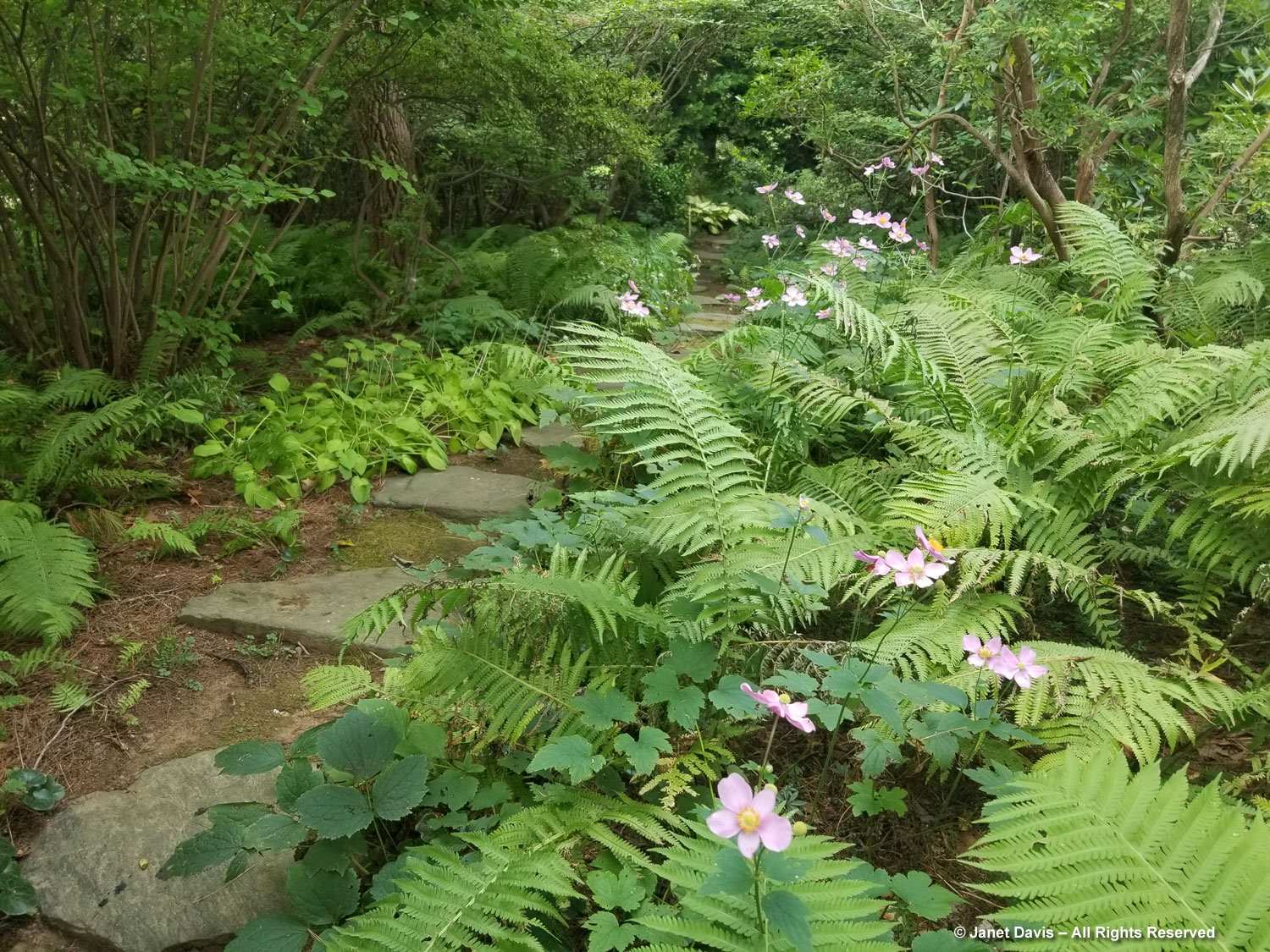
I loved this artful bench, just one of numerous handsome places to sit in Chanticleer’s gardens.
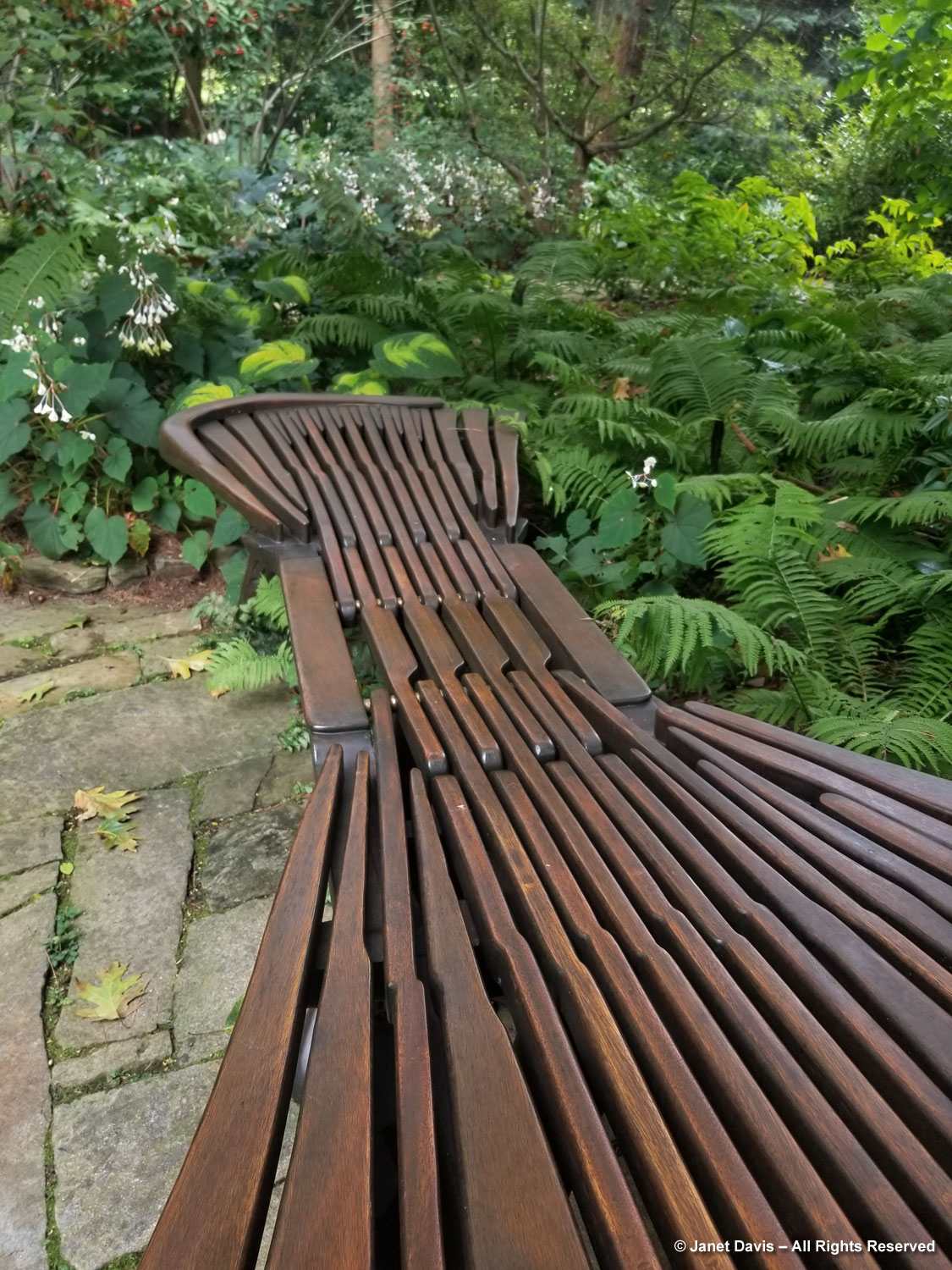
This tea viburnum (V. setigerum) is known for its dependable autumn display of berries.

Japanese toad lily season had begun; the one below is Tricyrtis hirta ‘Miyazaki’.
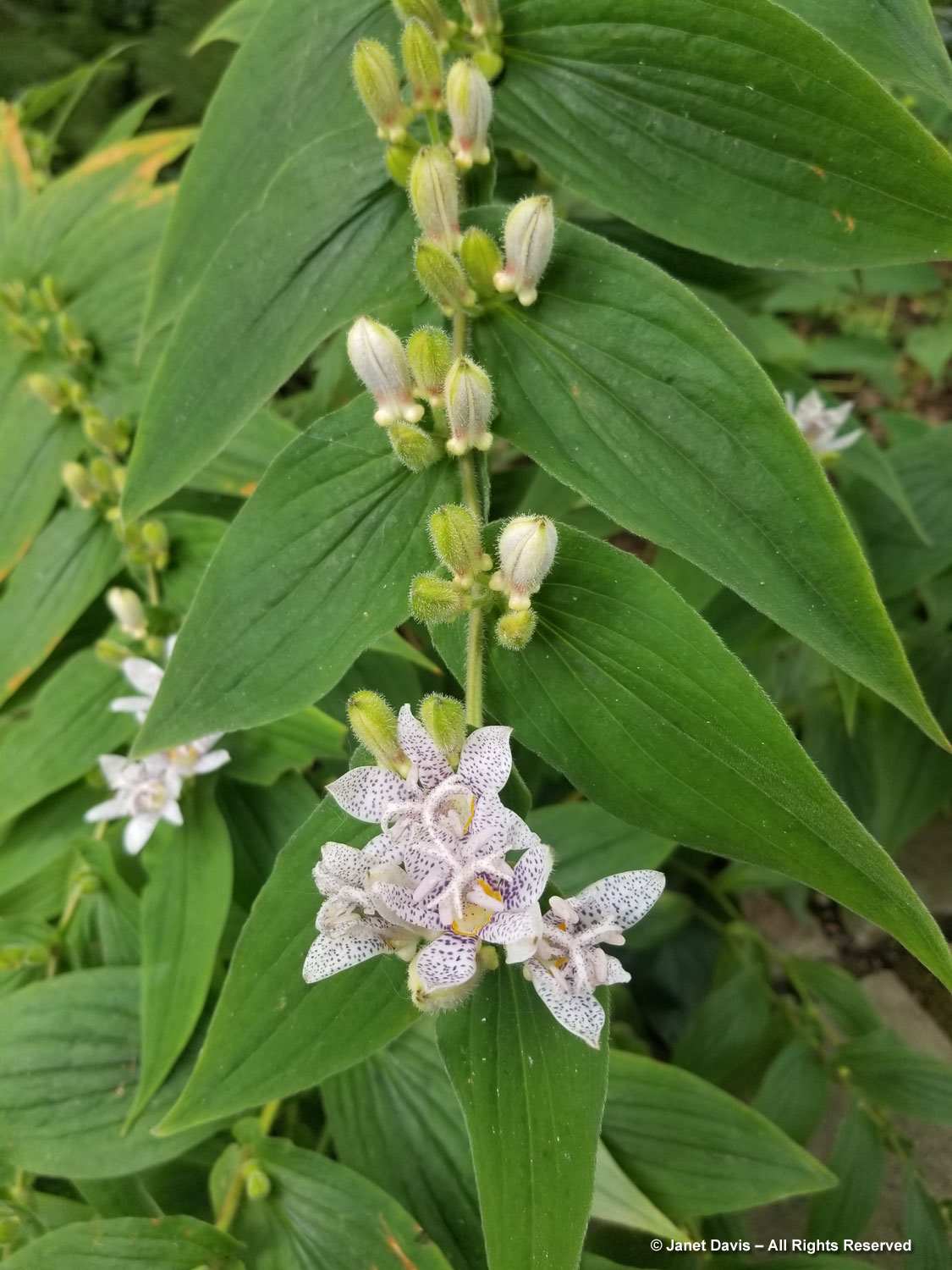
Though I grow a few species of snakeroot, I had never seen this compact one: Actaea japonica var. acerina.

Touring the Gravel Garden, below, is a little like walking into a drought-tolerant plant treasure box. Situated on a sunny, south-facing slope, it is packed with plants thriving in gritty soil that has also been top-dressed with gravel. Plants might be native drylanders, Mediterranean species, succulents or cacti. Below, a big beaked yucca (Y. rostrata) adds exclamation marks to one bed. Though this yucca is cold-hardy, any tender plants used here are moved by cart to heated greenhouses for the winter.

I had to work to find the name of the yellow-flowered plant in the trough on the right; it’s Bigelowia nuttallii, Nuttall’s rayless goldenrod.
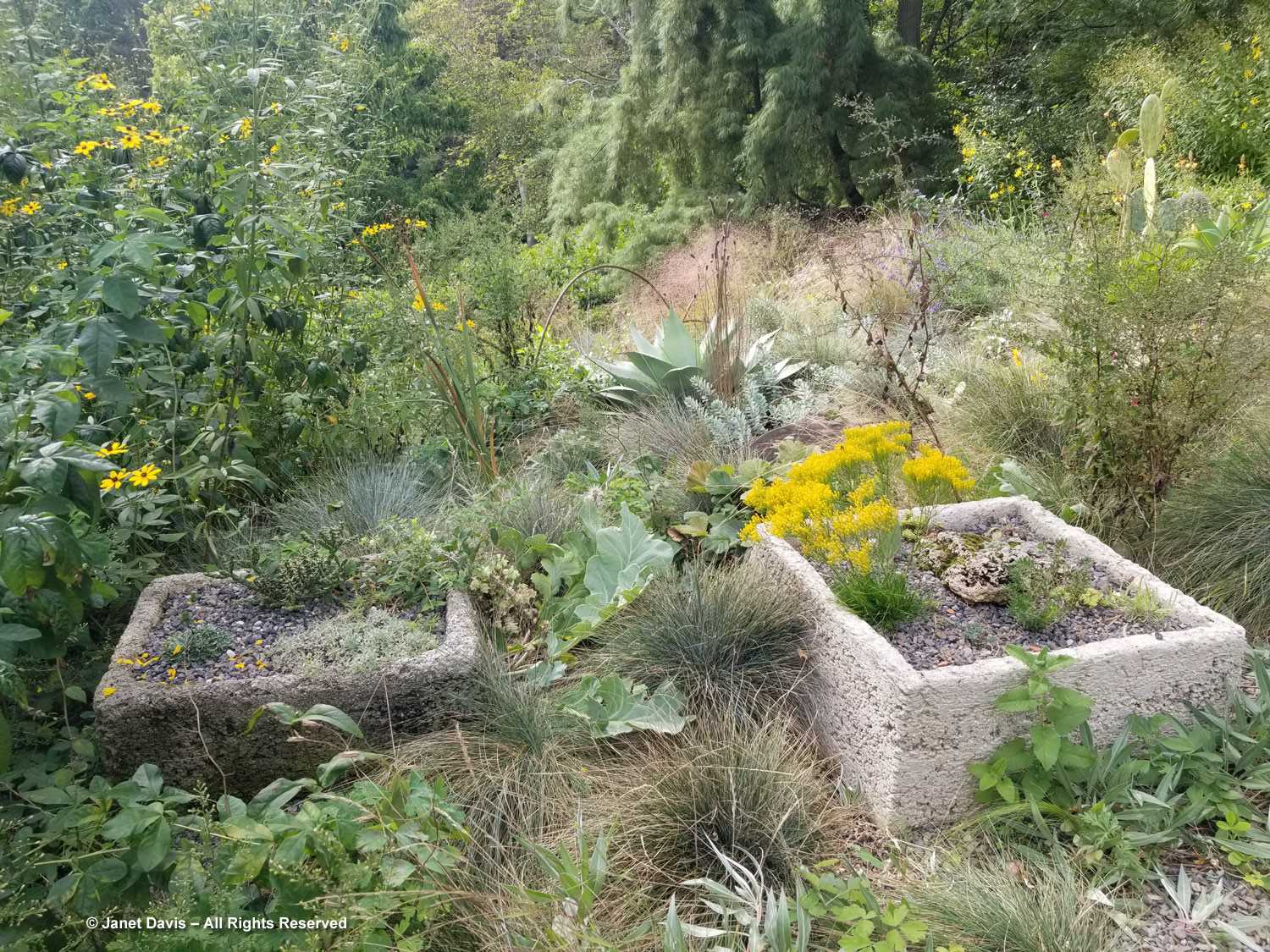
Look at this beautiful Agave attenuata in its trough. Alongside is an interesting prickly-pear cactus that I think might be Opuntia cochenillifera ‘Variegated’.
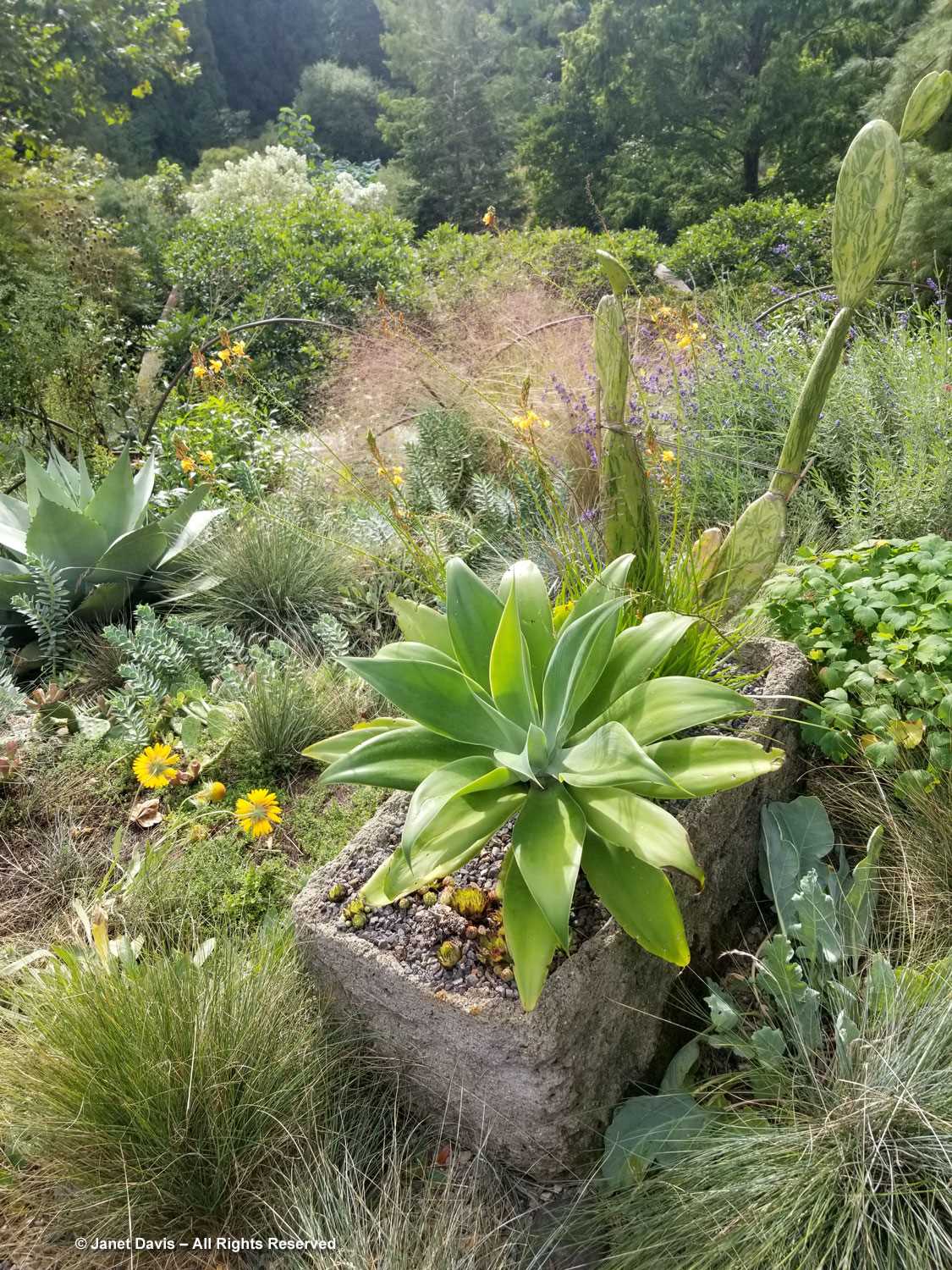
Lisa Roper, the Gravel Garden horticulturist (and my friend) likes to combine different plant textures, for example the big century plant (Agave americana) below with fine-textured plants like lavender and santolina. Oh, and that lovely little purple-flowered plant?
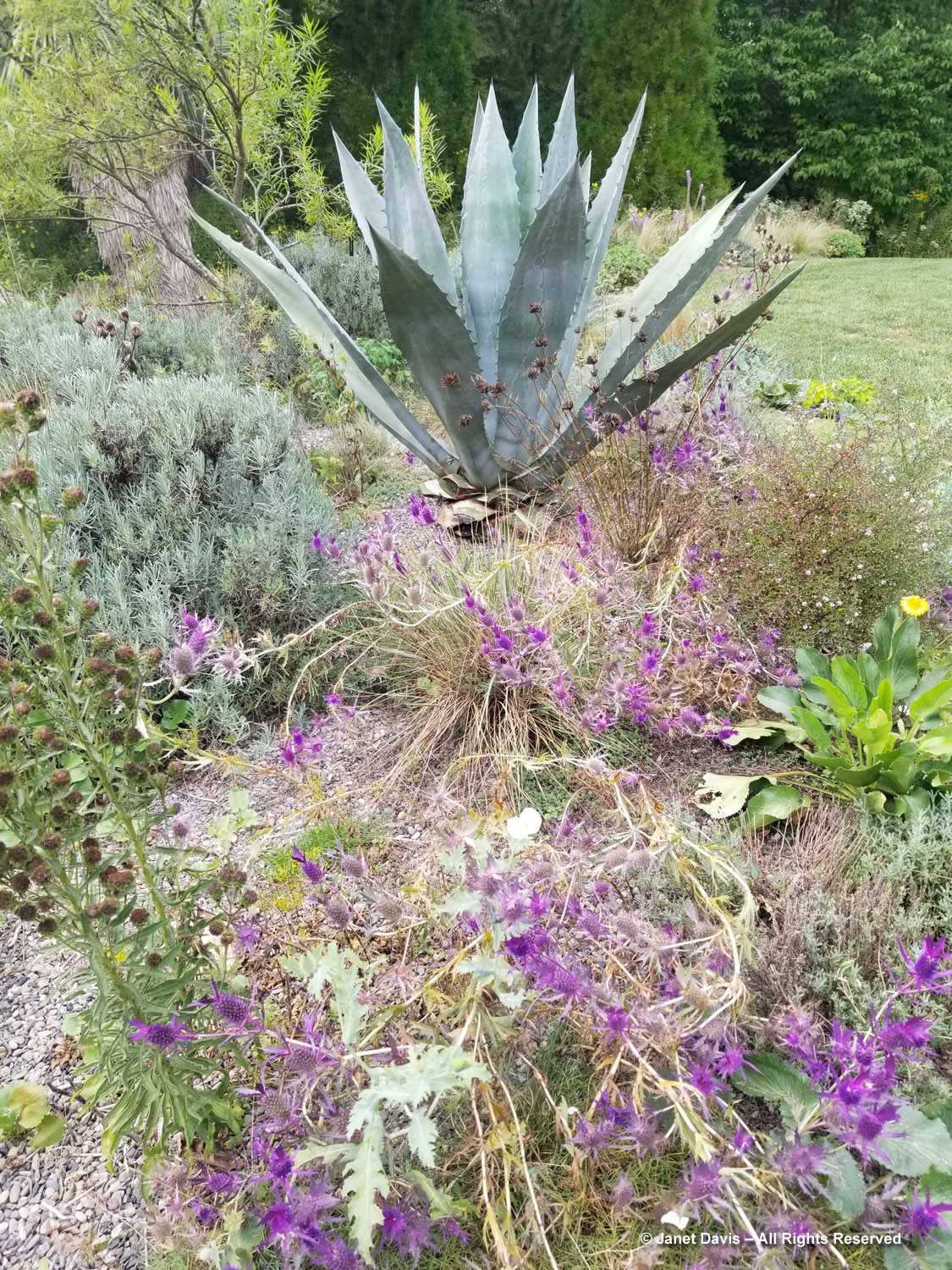
I’m so glad you asked! I asked Joe Henderson and he supplied the name. It’s Eryngium leavenworthii or Leavenworth’s eryngo, an annual native to dry, rocky prairies and waste places in the central U.S.

The gravel garden occupies niches and stone steps up a gently-sloped hill. In fact, each step has its own little collection in Chanticleer’s plant list which is updated yearly. Mexican feather grass (Nassella tenuissima) is allowed to self-seed around, but all self-seeders are carefully edited — a chore in rich gravel.
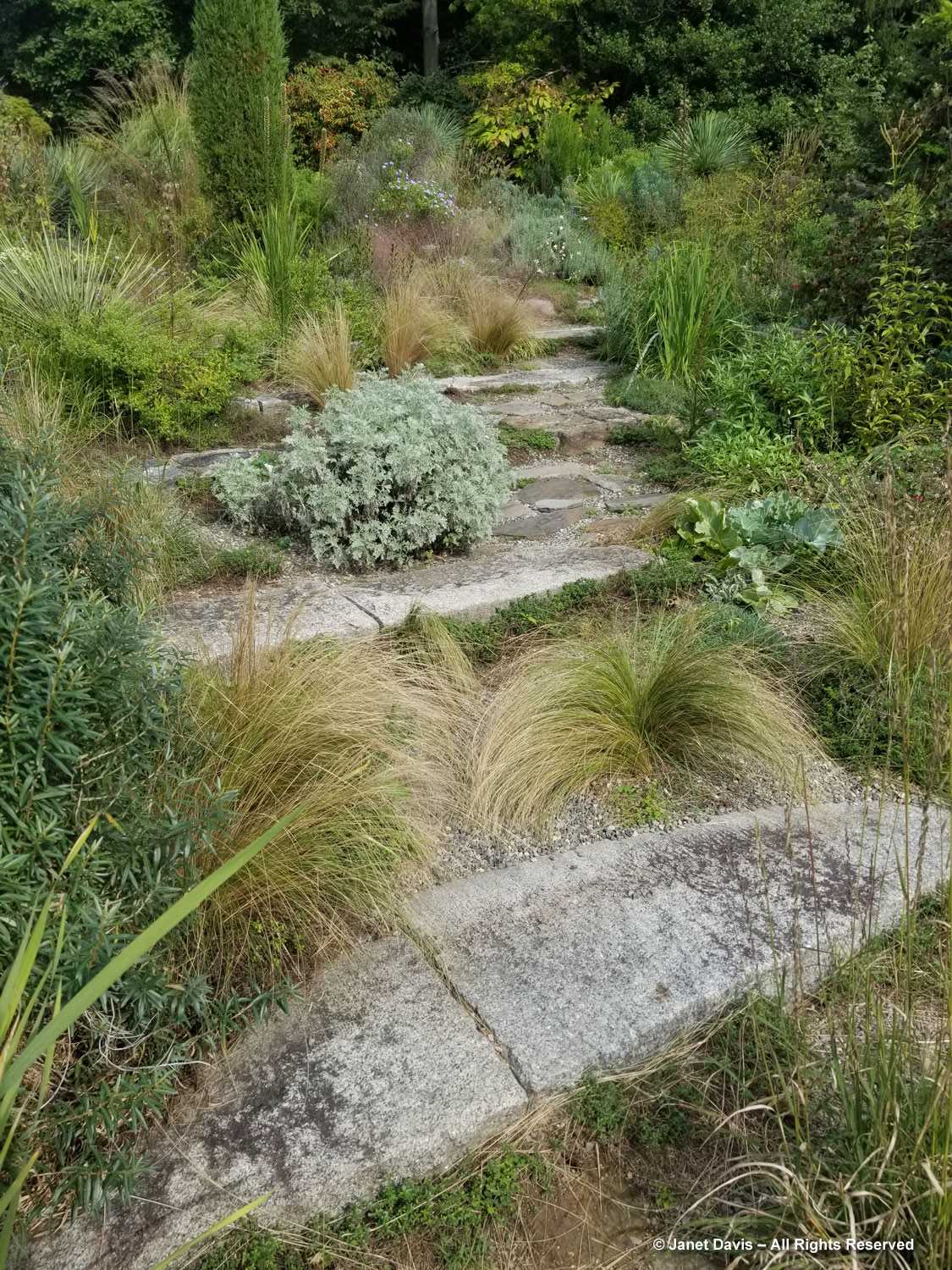
Seedheads offer a clue to what was blooming here in summer, like the wand-like Liatris microcephala and the Seseli gummiferum with its umbel inflorescence, below.

Lisa incorporates lots of interesting gladiolus species in the garden, including the beauty below, which I believe to be G. oppositiflorus.
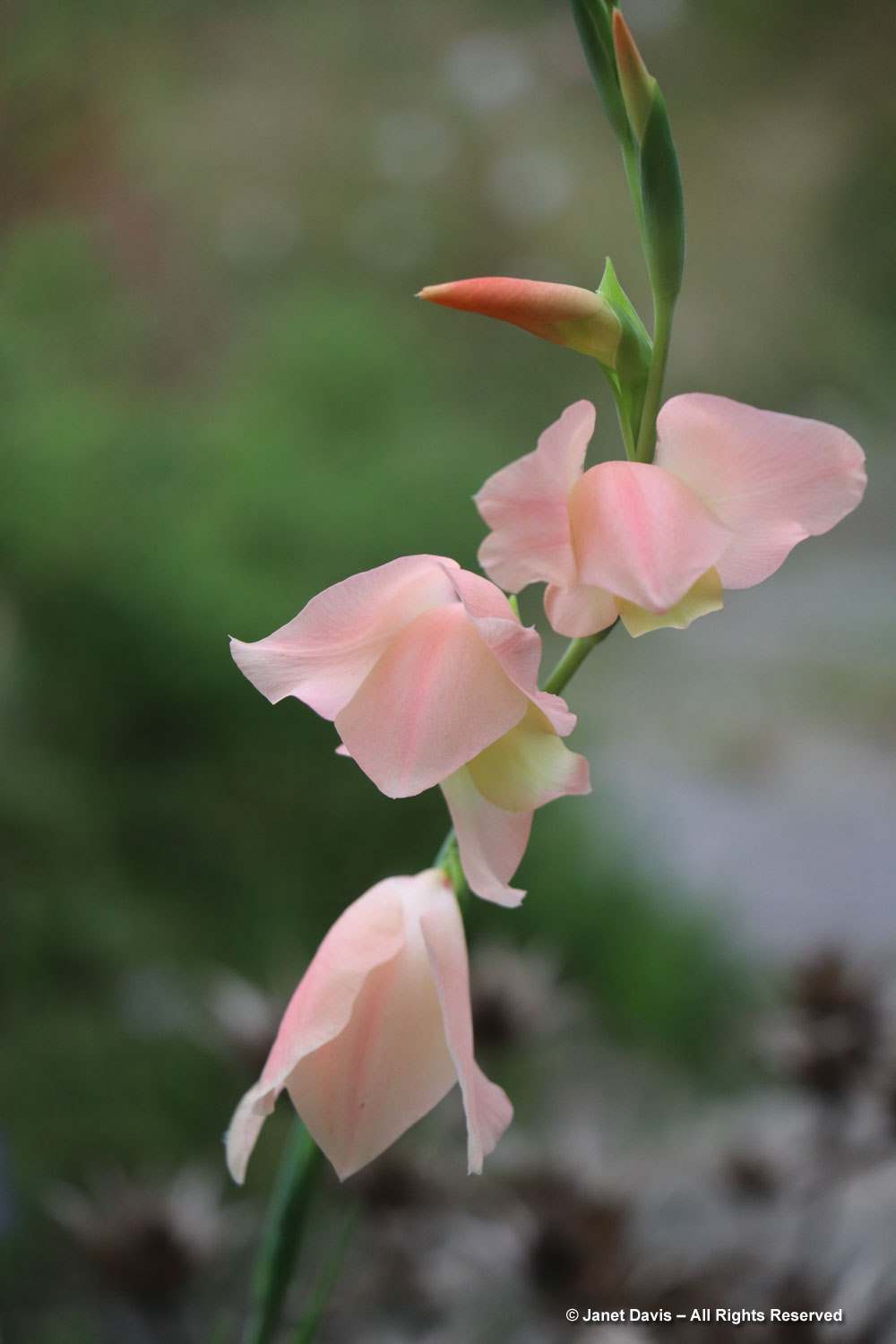
Of the fine-textured carexes and grasses, this seep muhly grass stands out, Muhlenbergia reverchonii.

I had to ask my friends on Facebook’s Plant Idents page to help me out with an i.d. for the plant below. We finally came up with the genus Pseudognaphalium.… and then I was able to refer to the online plant list to give us the species P. obtusifolium, better known as sweet everlasting, or rabbit tobacco. It has a rich ethnobotanical history.
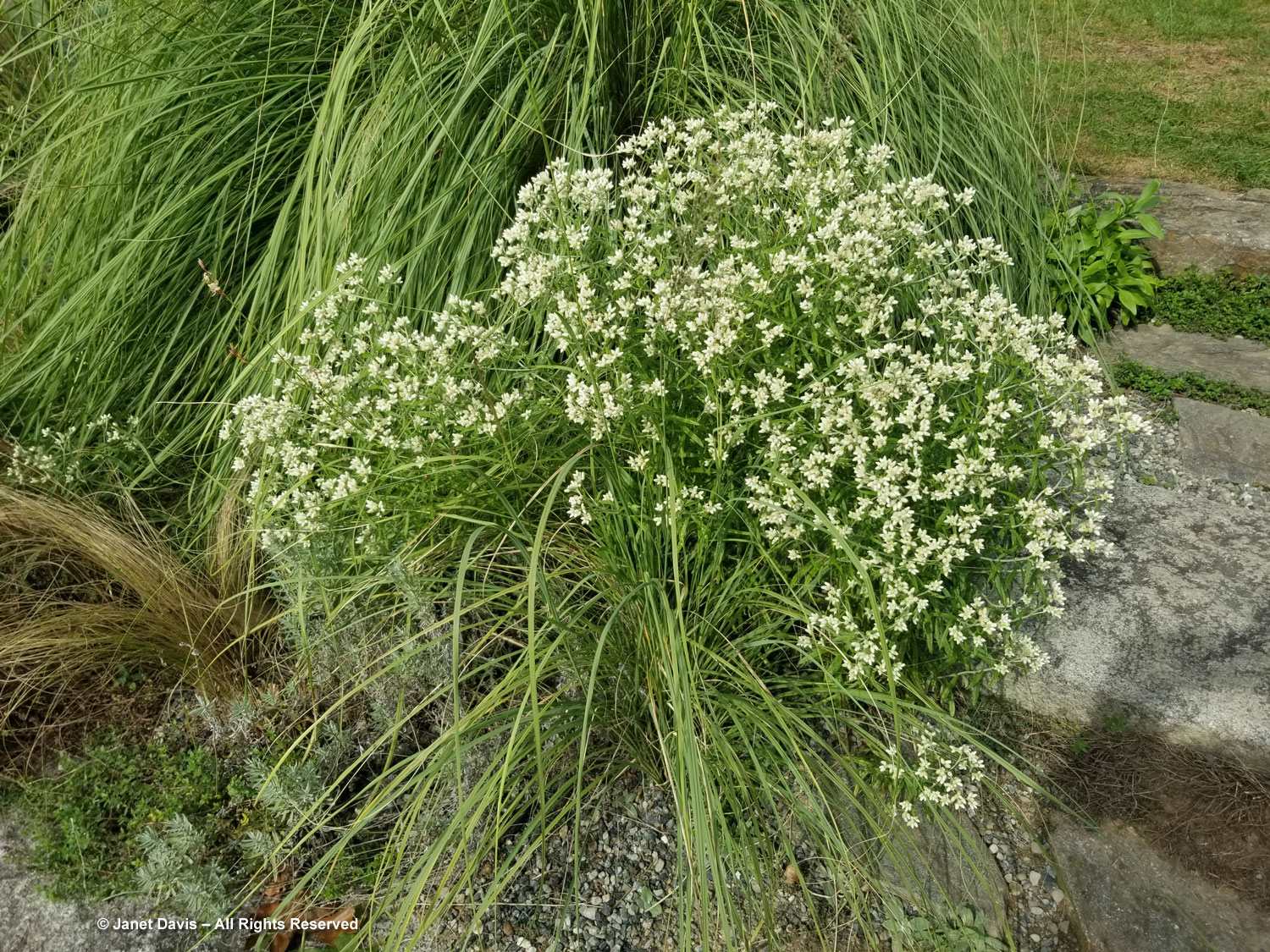
I could have stayed in the Gravel Garden all night, but our 4-hour stay meant I had to keep moving, so down I went to explore the sweeping beds between the Gravel Garden and the great lawn below the main house. These beds are considered part of Minder Woods. They’re always inspiring and often seem to have a purple-and-orange theme, including big purple alliums and orange kniphofia I photographed one spring. This time of year, asters (Symphyotrichum laeve ‘Bluebird’), Russian sage (Salvia yangii/Perovskia atriplicifolia) and tender sages like Salvia ‘Amistad’ and Salvia leucantha form the purple/blue palette while the orange is supplied by Zinnia ‘Queen Lime Orange’, tall ‘Garland Orange’ marigolds (Tagetes erecta), Cosmos sulphureus ‘Sunset Orange’, Mexican sunflowers (Tithonia rotundifolia) and dahlias ‘Sonic Boom’, ‘Kabloom’, ‘Honeymoon’ and ‘David Howard’, among others.

The orange flowers below include zinnia, cosmos and marigold. In these photos you can also see the first year rosettes of the biennial verbascums that will tower in these beds next year.
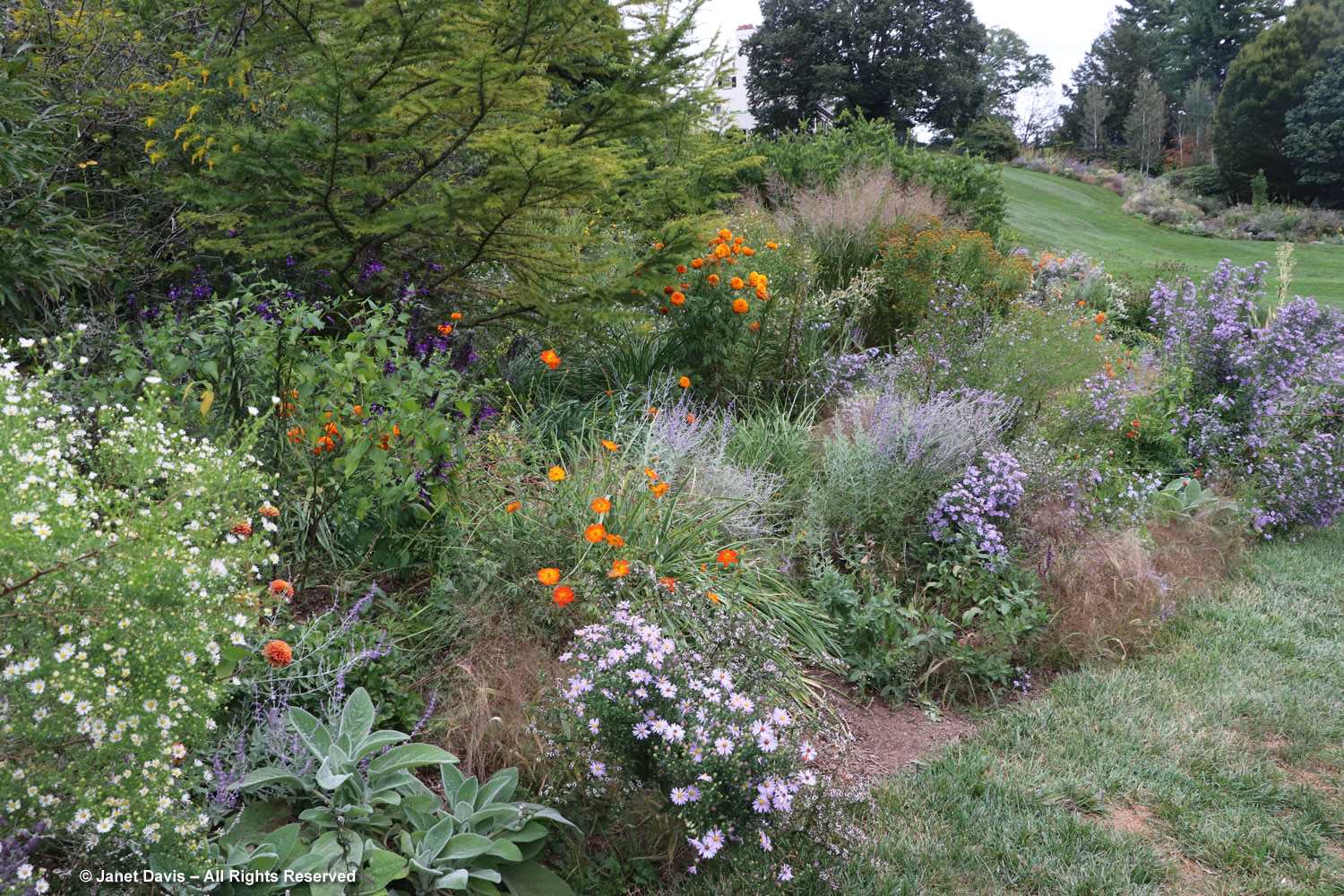
What would our late summer-autumn gardens be without asters? Chanticleer uses a combination in its gardens, but the taller lavender-lilac ones seem to be Symphyotrichum laeve ‘Bluebird’.
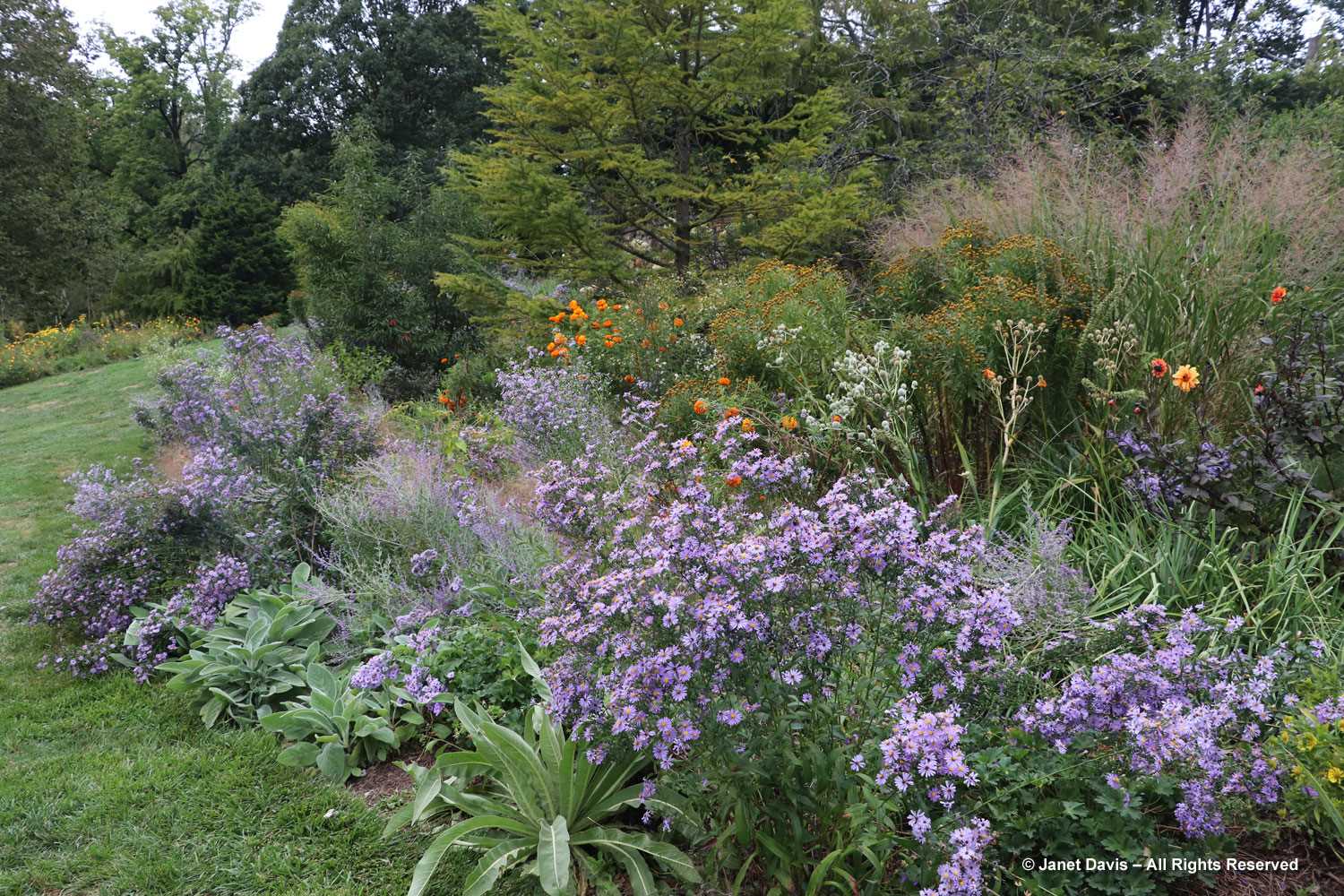
Well-grown annuals add so much to the late summer garden. Below is the fabulous, tall zinnia, ‘Queen Lime Orange’. On the right is tender Mexican sage, Salvia leucantha ‘Santa Barbara’. The hydrangea is H. paniculata ‘Limelight’.
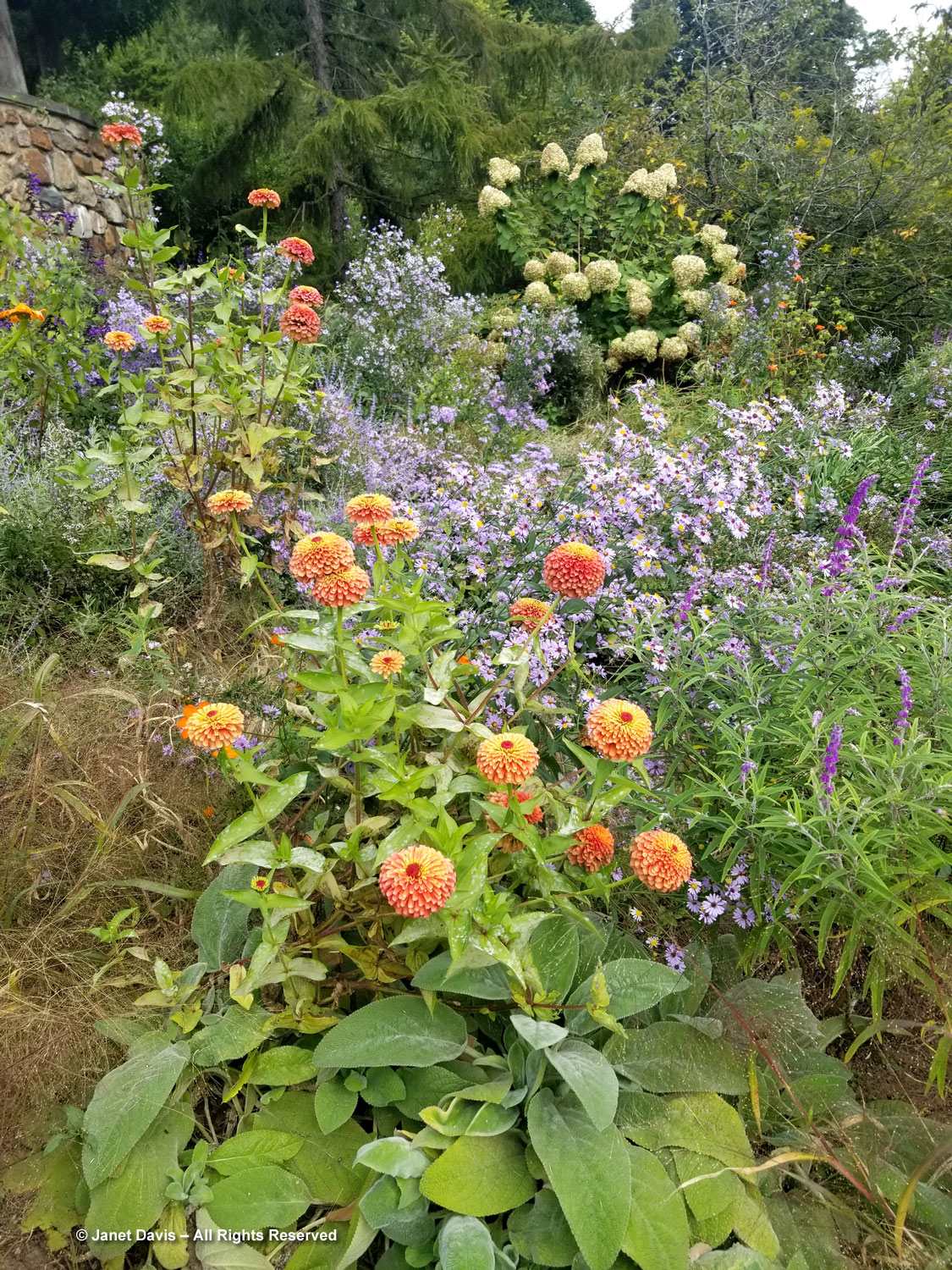
Adding a screen-like grass in front of plants turns plant design into a bewitching form of stagecraft. That’s purple love grass (Eragrostis spectabilis), below……

…. and look how it serves as a mysterious scrim curtain in front of the brilliant zinnias. Isn’t it magical?
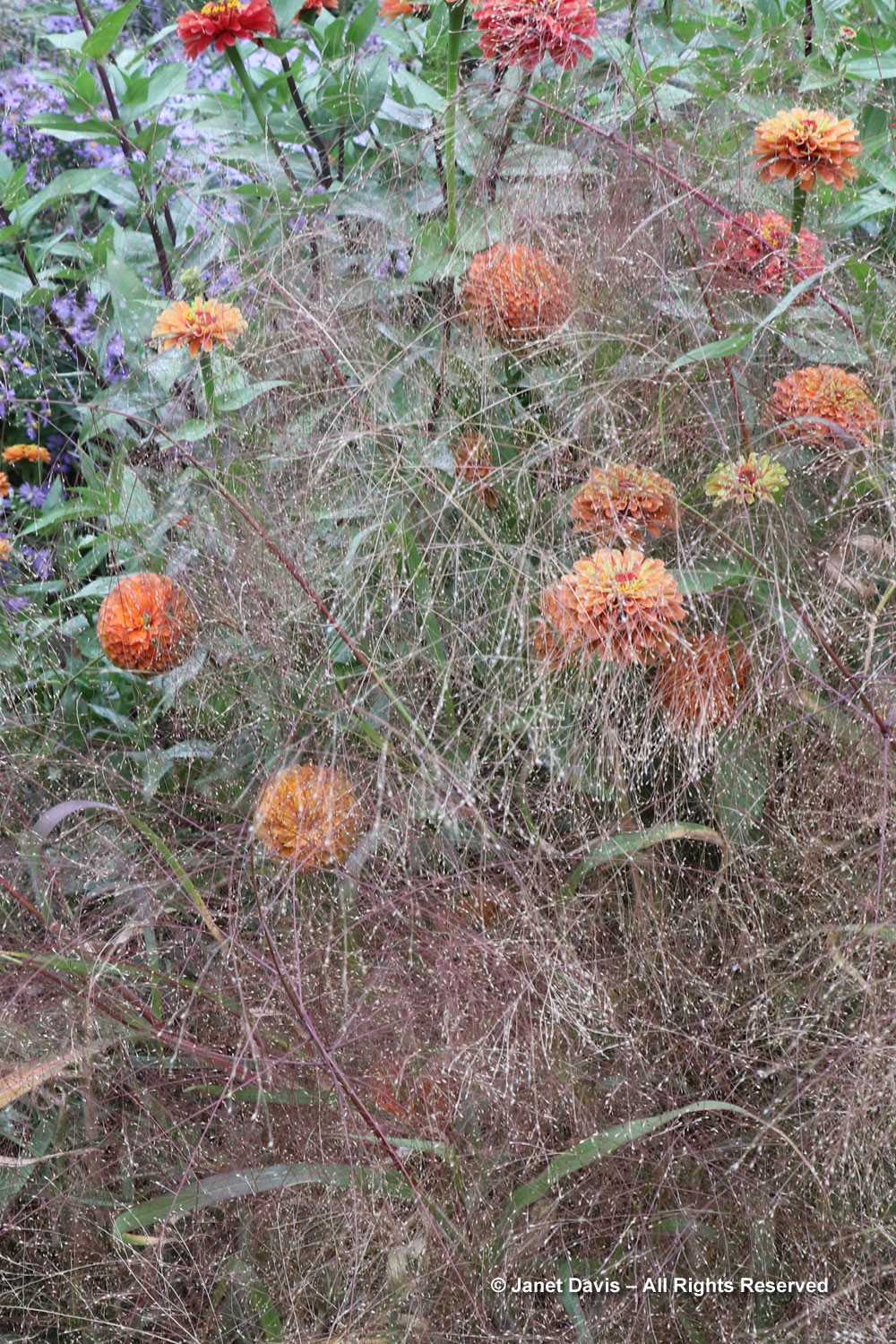
The Elevated Walk was built in 2015 to access the main house from the ponds and the great lawn below, and its plant roster has matured beautifully now. Here is that white-flowered sweet everlasting again, along with the compact Russian sage ‘Little Spire’ and rattlesnake master. The wine-coloured seedheads are Angelica gigas. The walkway itself is composed of porous materials.
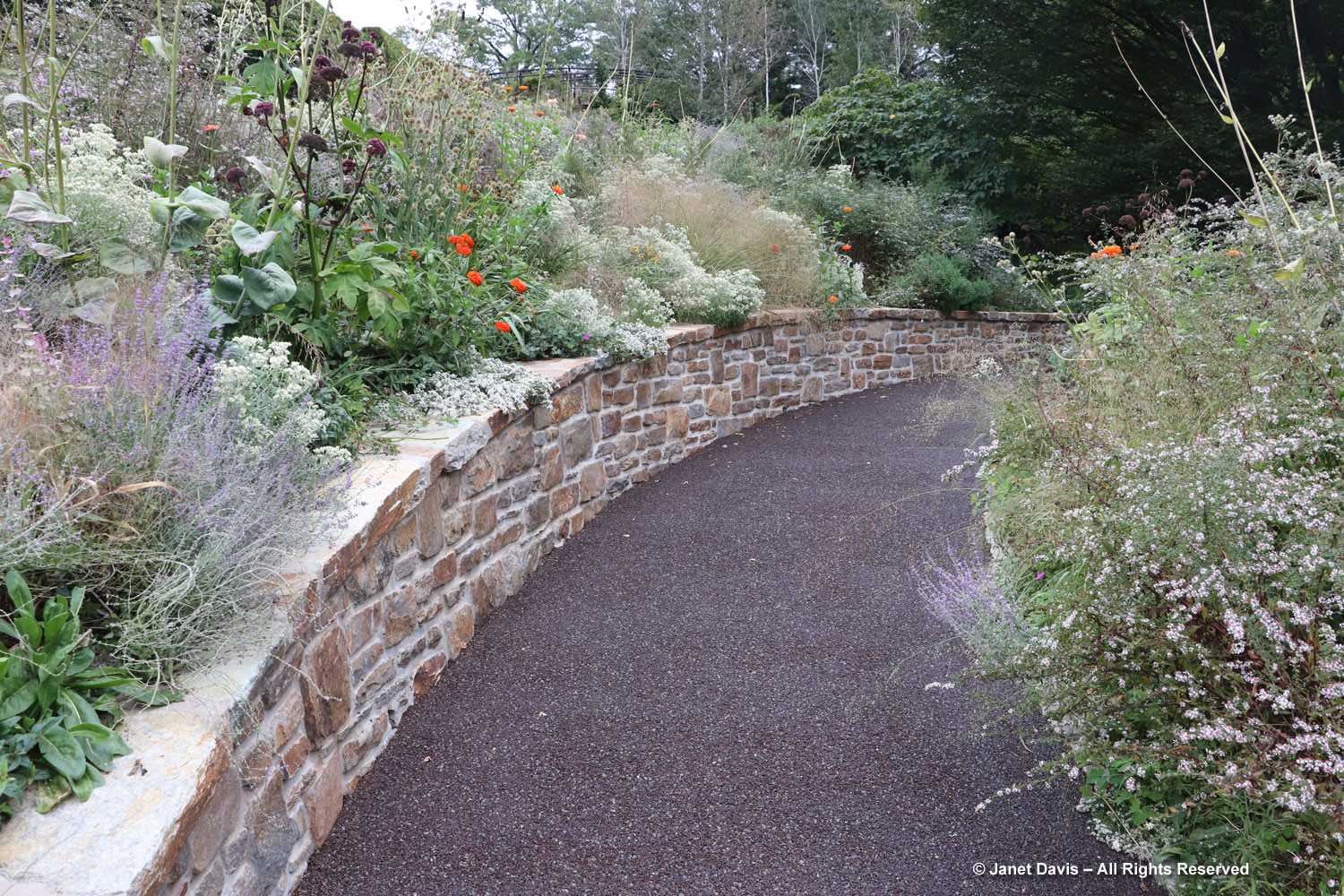
The areas beneath the Elevated Walk are also planted with trees, shrubs and perennials, like the Aspen Grove, below. That means they’re at eye level with visitors on the walkway, a little like a treetop walk in other gardens.

With its persistent seed heads, rattlesnake master (Eryngium yuccifolium) adds seasons of interest to a border. And those oblong, dark seedheads belong to Rudbeckia maxima.

The Apple House occupies a place of honor on the walkway. Go inside and you’re treated to fabulous, colourful murals – but no apples these days.
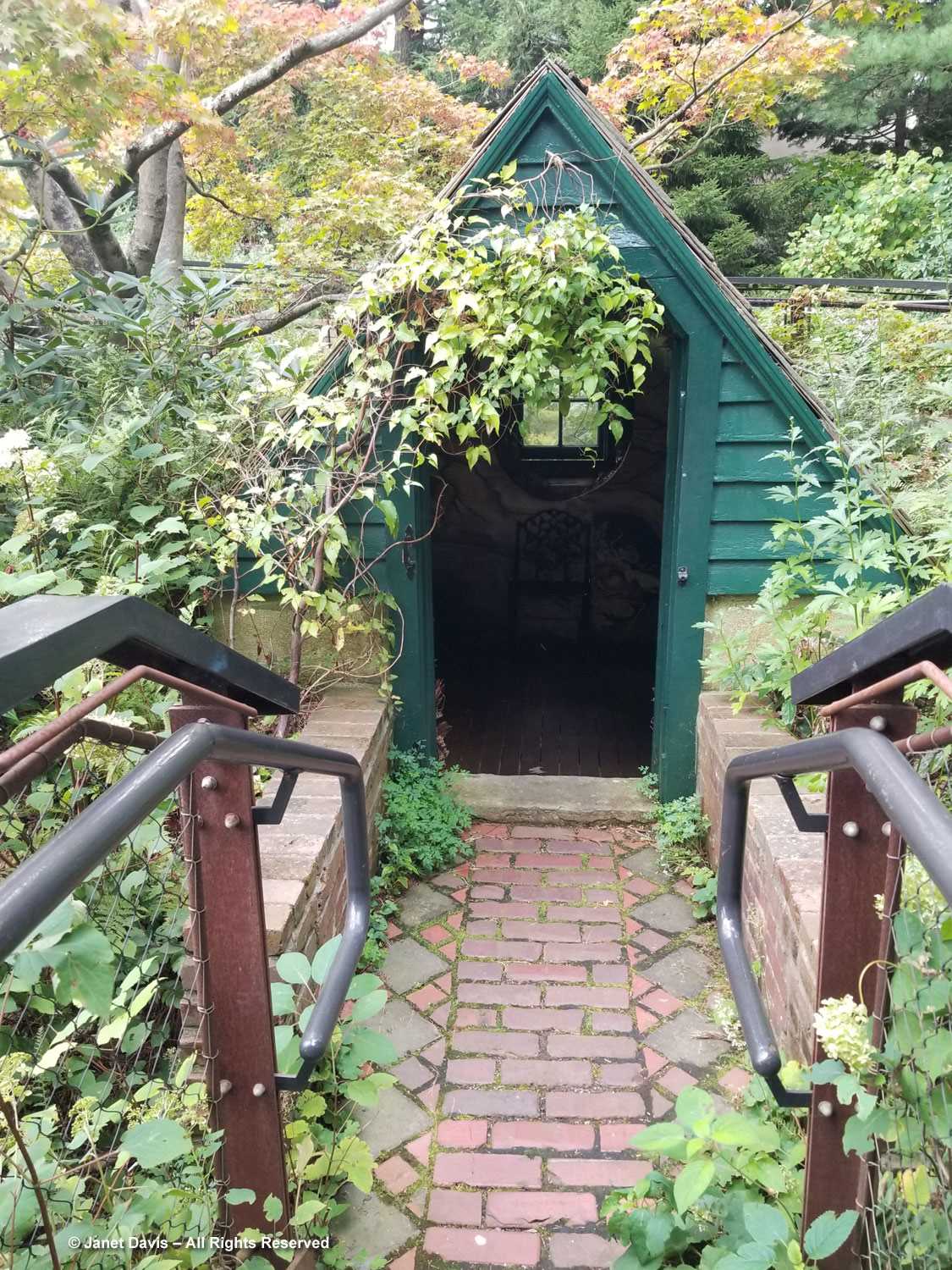
A few of my fellow garden bloggers stopped on the Elevated Walk to admire the fall-changing foliage of this beautiful Japanese maple (Acer palmatum subsp. amoenum). And look at that stunning railing

The prize at the top of the walkway is Chanticleer House, once home to Adolph Rosengarten Sr. and his wife, and also the setting for several colourful flower beds, like the one in the Overlook below, punctuated by spears of the succulent Furcraea foetida ‘Mediopicta‘. The variegated plant at right is Euphorbia x martinii ‘Ascot Rainbow’.

I grew angelonia (purple plant below) for the first time this summer, and though it lasted in flower for months, I didn’t see one bee or butterfly on it. Too bad – otherwise the perfect bedding annual. Blue-flowered Salvia farinacea, on the other hand, is a great pollinator plant. The nodding, white and pink flowers are South African foxglove (Ceratotheca triloba).

The fluffy white flowers below belong to Euphorbia hypericifiolia Breathless Blush.

The house terrace always features an array of chartreuse-leaved plants. I’m not exactly sure what the chartreuse plant below is, but it might be Salix sachalinensis ‘Golden Sunshine’.
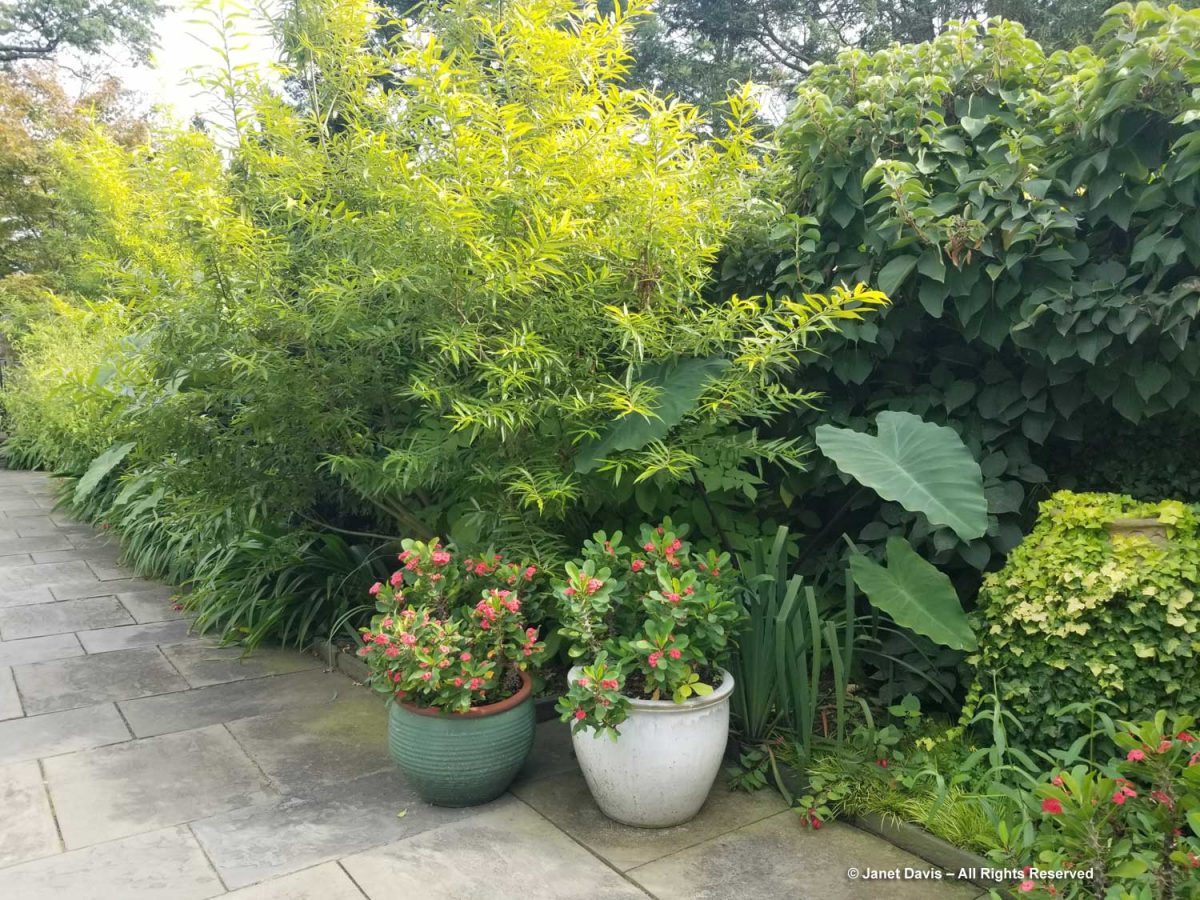
This border was tropical-looking, with its spiky golden bromeliads (Aechmea blanchetiana Hawaii). The phormum at right is ‘Pink Panther’.

I love the little gloriosa daisy at front, R. hirta ‘Zahara’. The twirly, brown foliage plant at the rear is Acalypha wilkesiana ‘Ceylon’.
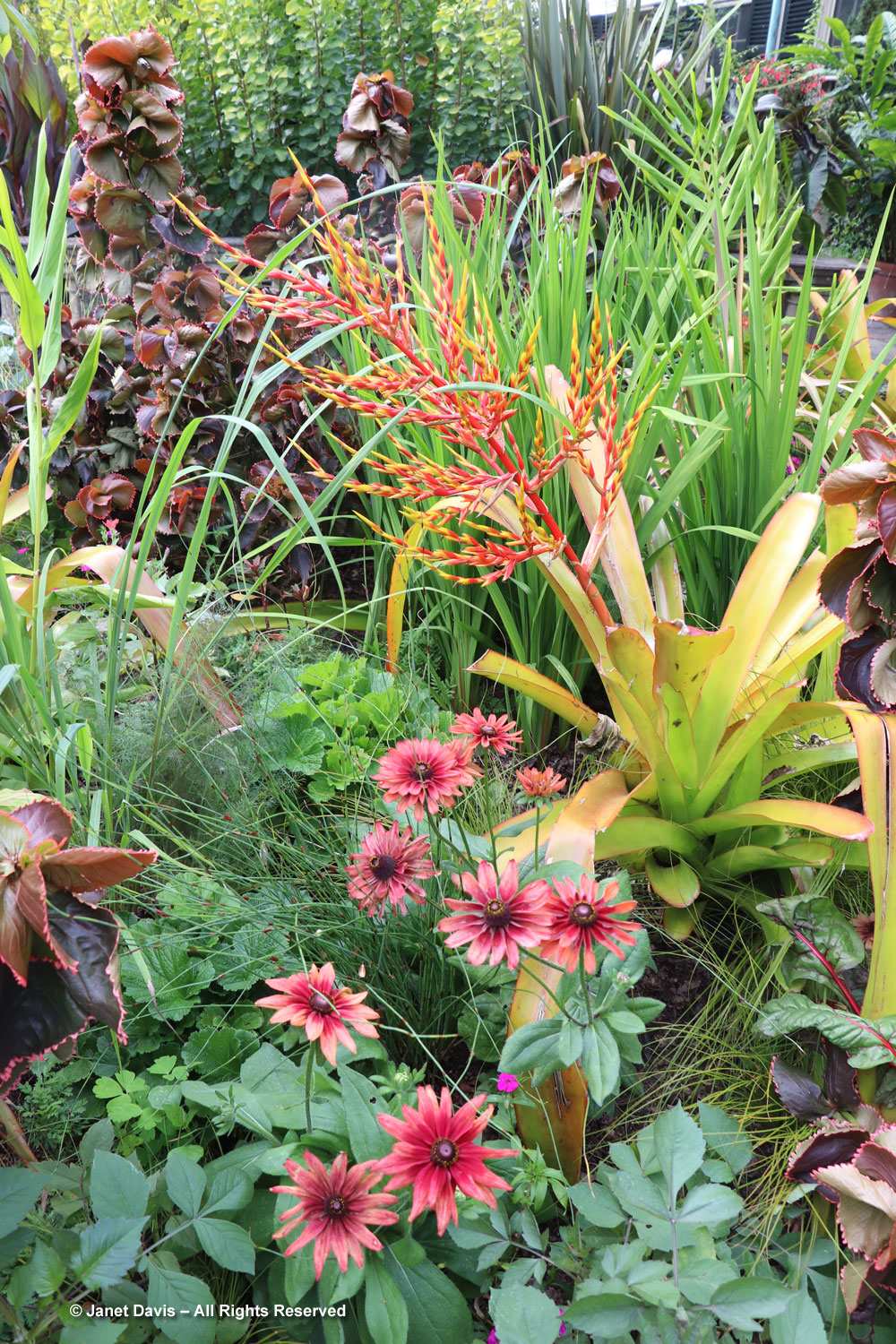
Dozens of pots were arrayed in front of Chanticleer House, and those with dark leaves played nicely with the dark shutters.

And here is a charming gesture that sets Chanticleer apart from so many gardens. There is always a basin filled with colourful floating flowers and leaves plucked from the gardens. This one even contains the green fruit colloquially known as, yes, “hairy balls”, but is more properly called Gomphocarpus physocarpus. A tender shrub related to milkweeds, it also provides food for monarch butterfly caterpillars.

A few of my fellow garden bloggers were relaxing on the sun porch. Originally glassed-in, it was a favourite lookout for Adolph Rosengarten Sr’s wife, Christine Penrose Rosengarten.
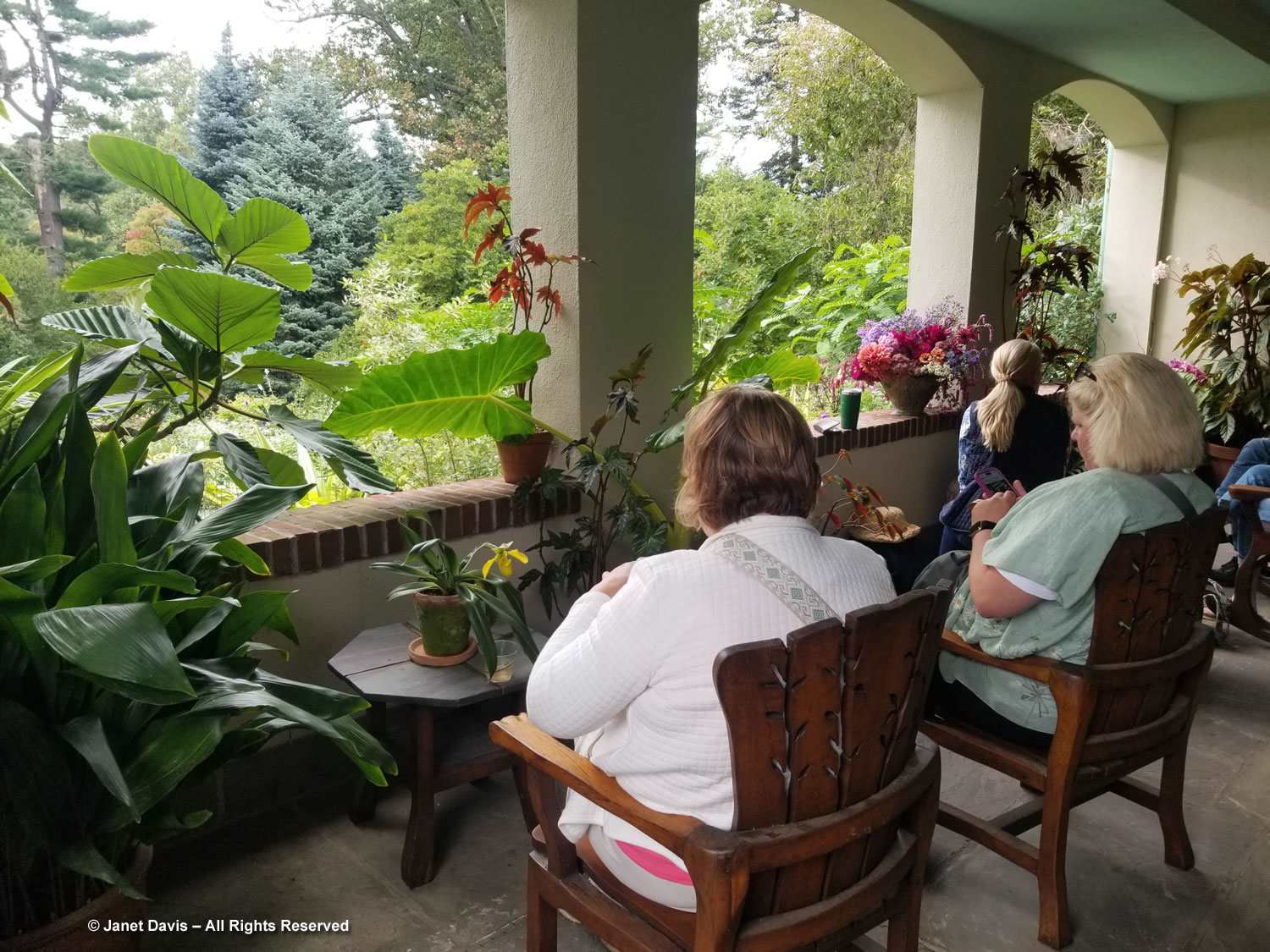
The porch featured one of the many beautiful floral arrangements crafted from the garden’s flowers. (And there is that spectacular ‘Harvey Koop’ dahlia from the Cutting Garden in Part One!)

As a confirmed ‘meadow gardener’, one of the reasons I was overjoyed to be visiting Chanticleer in late summer was the chance to see the Flowery Lawn. Originally a rectangle of manicured turfgrass between the house and swimming pool, the decision to let it become a tended meadow was such a good one. In spring, it’s all daffodils, but on this day it featured several types of anise hyssop (Agastache) including ‘Blue Fortune’, ‘Blue Boa’, ‘Little Adder’, ‘Purple Haze’ and ‘Serpentine’. Though native butterfly milkweed was out of bloom, tropical milkweed (Asclepias curassavica) added flashes of orange. The tall plant with yellow flowers is a daylily, Hemerocallis ‘September Sol’.

The dark-blue salvia with the anise hyssop is ‘Big Blue’ — and it looks to me like pale-mauve calamint (Calamintha nepeta) is in this garden too.
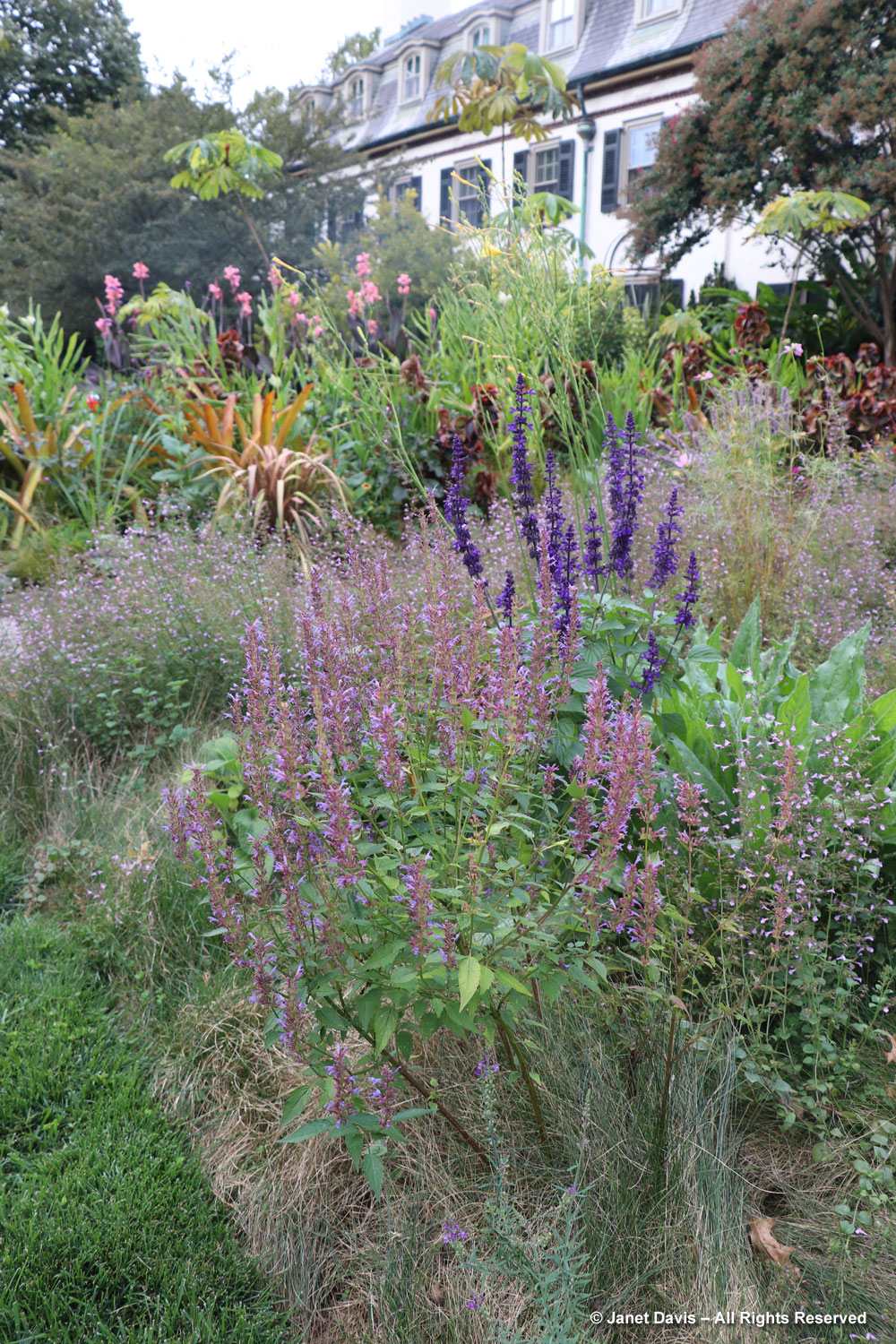
A lonely monarch butterfly was nectaring on the asclepias before the big migration south. In our region, it was a very poor summer for monarchs – I only saw 2 at our cottage, and no eggs on all my milkweed.
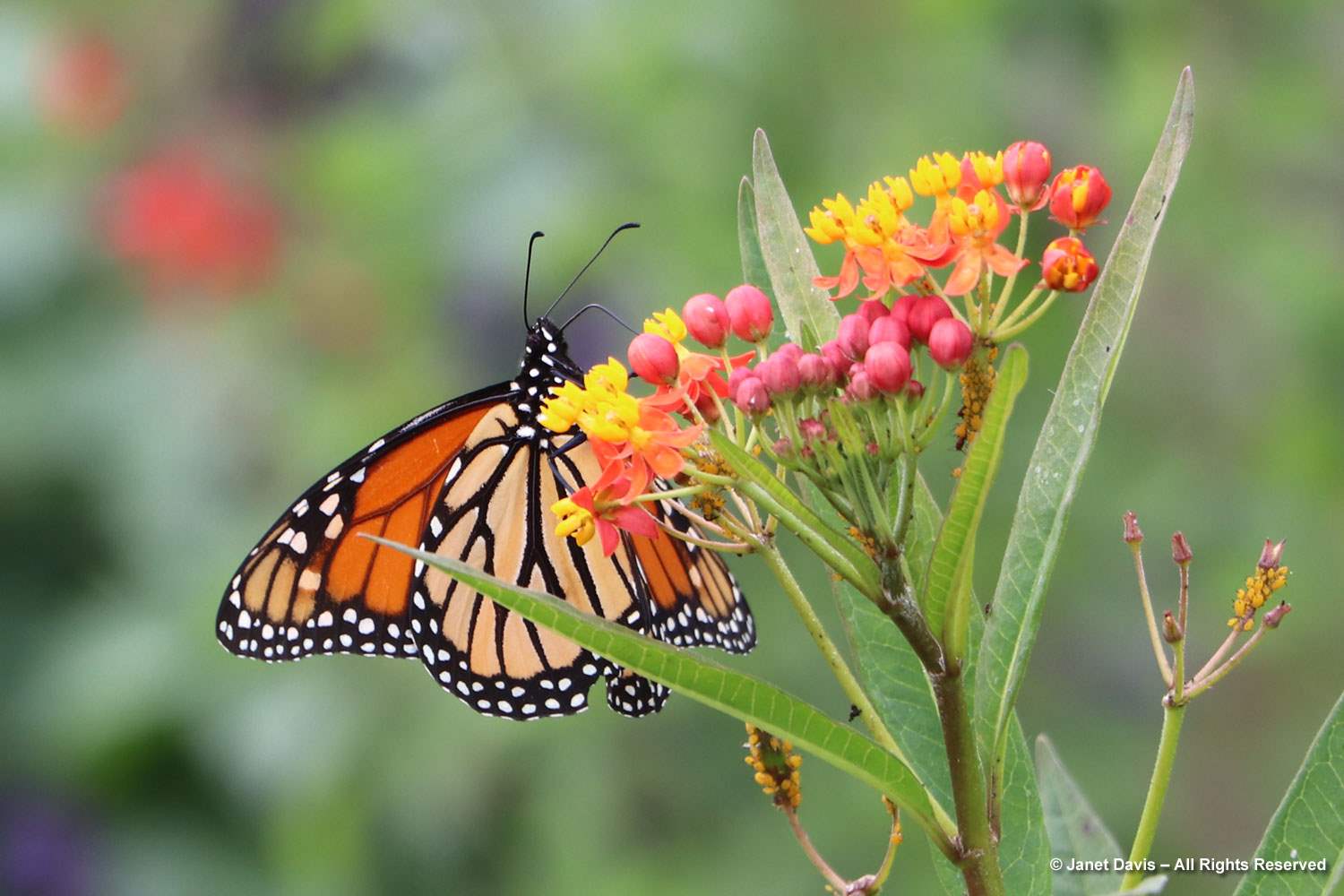
A big carpenter bee was foraging on the anise hyssop.

The bloggers were treated to a delicious Middle Eastern meal in the Chanticleer House garden, which gave me time to sit and enjoy yet another bouquet. I love the way the crimson amaranth cascades so nicely. Those tiny orange fruits, by the way, come from Talinum grandiflorum, aka “jewels of Opar”.
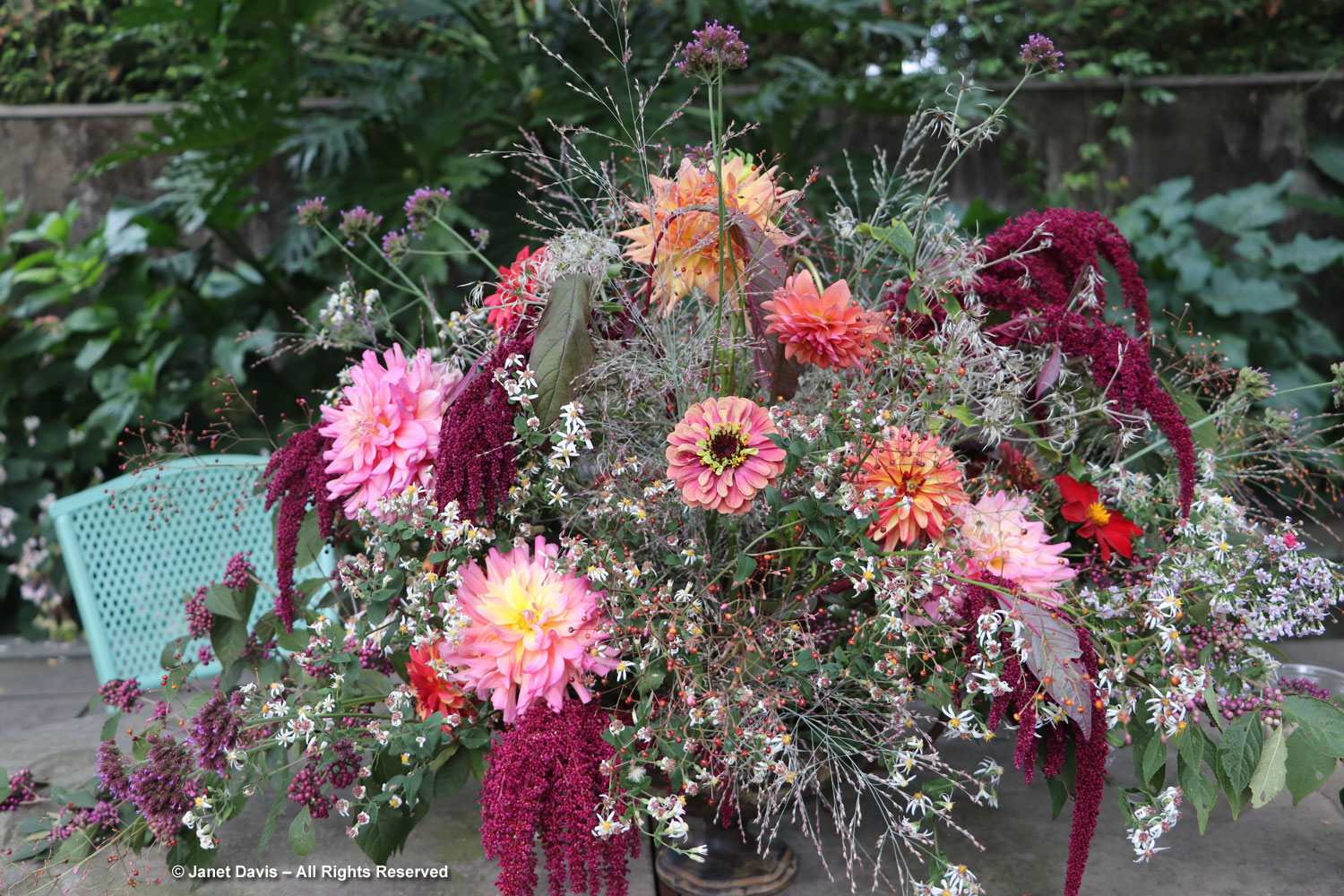
The swimming pool always look so inviting. (Way back in the day, a few decades ago, I did have a dip in that pool – invited, of course!)

The Old French literary word for rooster was chantecler and there are many carved versions at Chanticleer.

Who wouldn’t want to roost in this lovely garden, amongst silvery euphorbias and crambes?
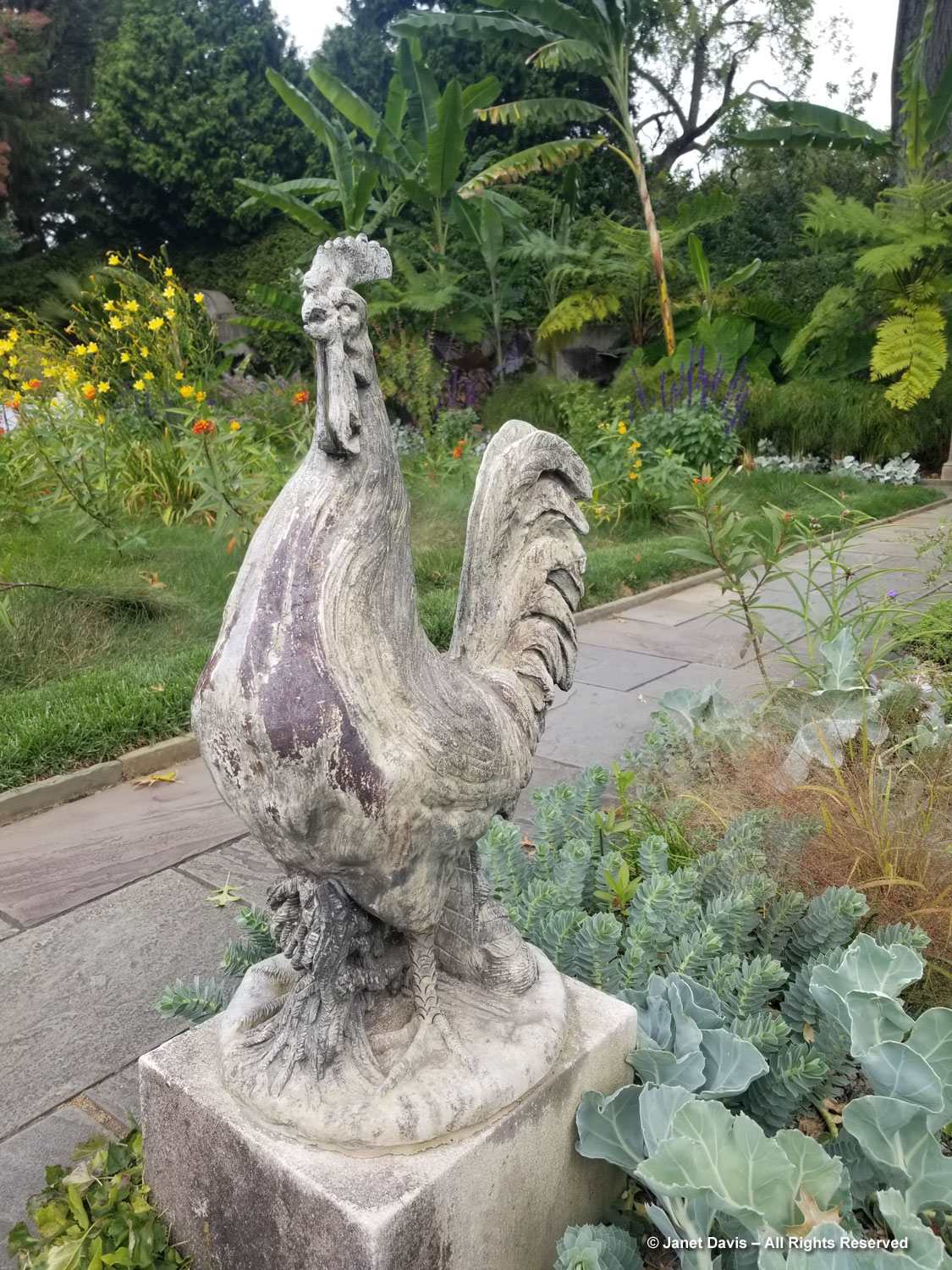
The East Bed forms the boundary to the house garden, and is filled with lush tropicals, like the bananas, ‘Hilo Beauty’ caladium, ‘King Tut’ dwarf cyperus, and more.

I’m always drawn to inspiring colour combinations, and this tropical duo in the East Bed rang my bell. The taro is Colocasia ‘Distant Memory’; the red-leaved Mexican native shrub is Euphorbia cotinifolia, sometimes called smoketree spurge.

Aiming for one last visit to the Teacup Garden, I walked out of the main house garden towards Emily’s house, i.e. the offices and visitor’s centre, where this massive oak tree was carpeted with Symphyotrichum ericoides ‘Snow Flurry’, a compact heath aster used extensively in many of the gardens.
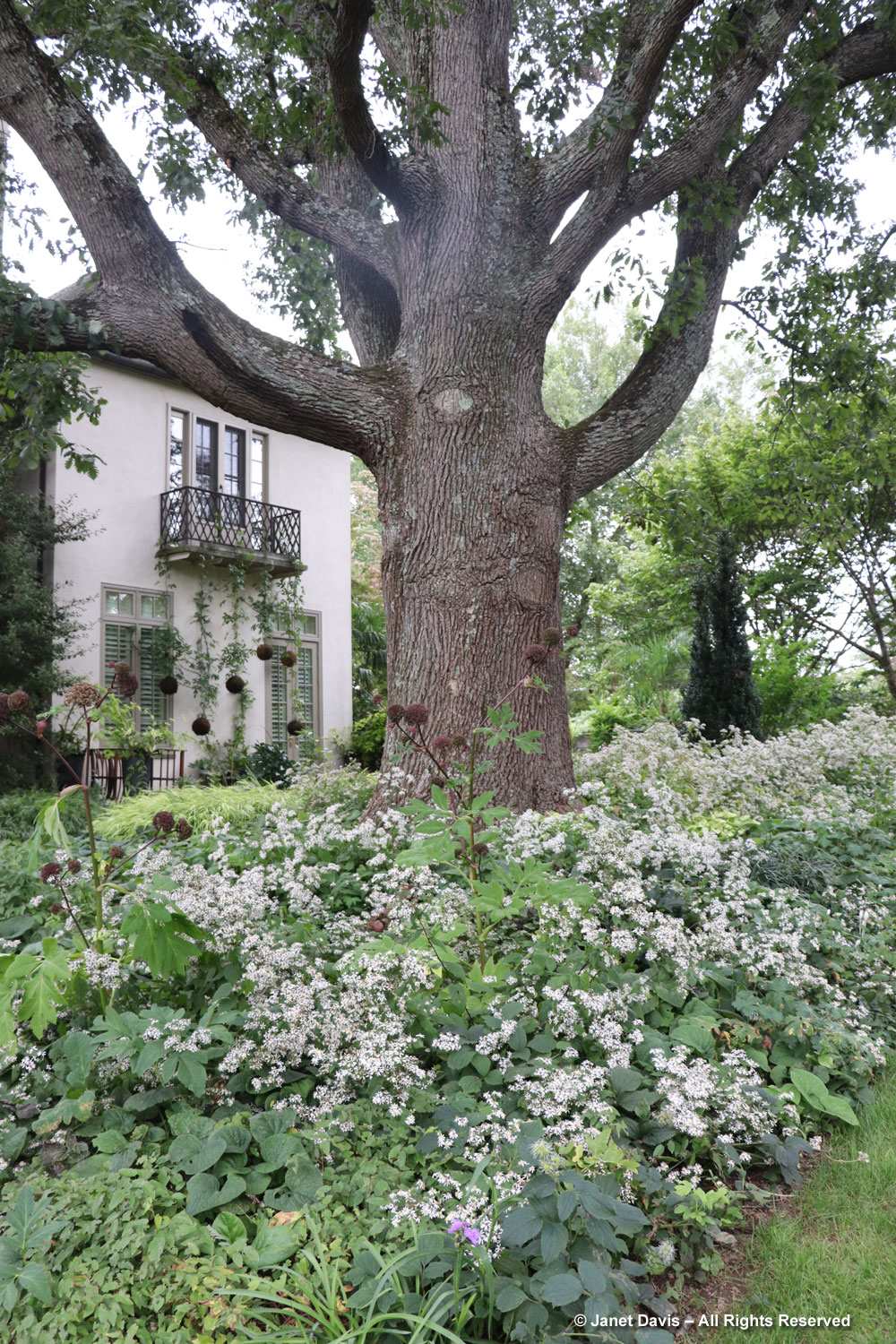
How much fun is this? Tropical lianas getting the balcony treatment.

I circled around the front of Emily’s house, where of course there were more spectacular plant designs.

This luscious arrangement of tropicals was my last plant photo, including strap-leaved Alcantarea imperialis, pink-leaved caladiums, canna lily, begonias and other delicious plants. And, of course, a bench for enjoyment.
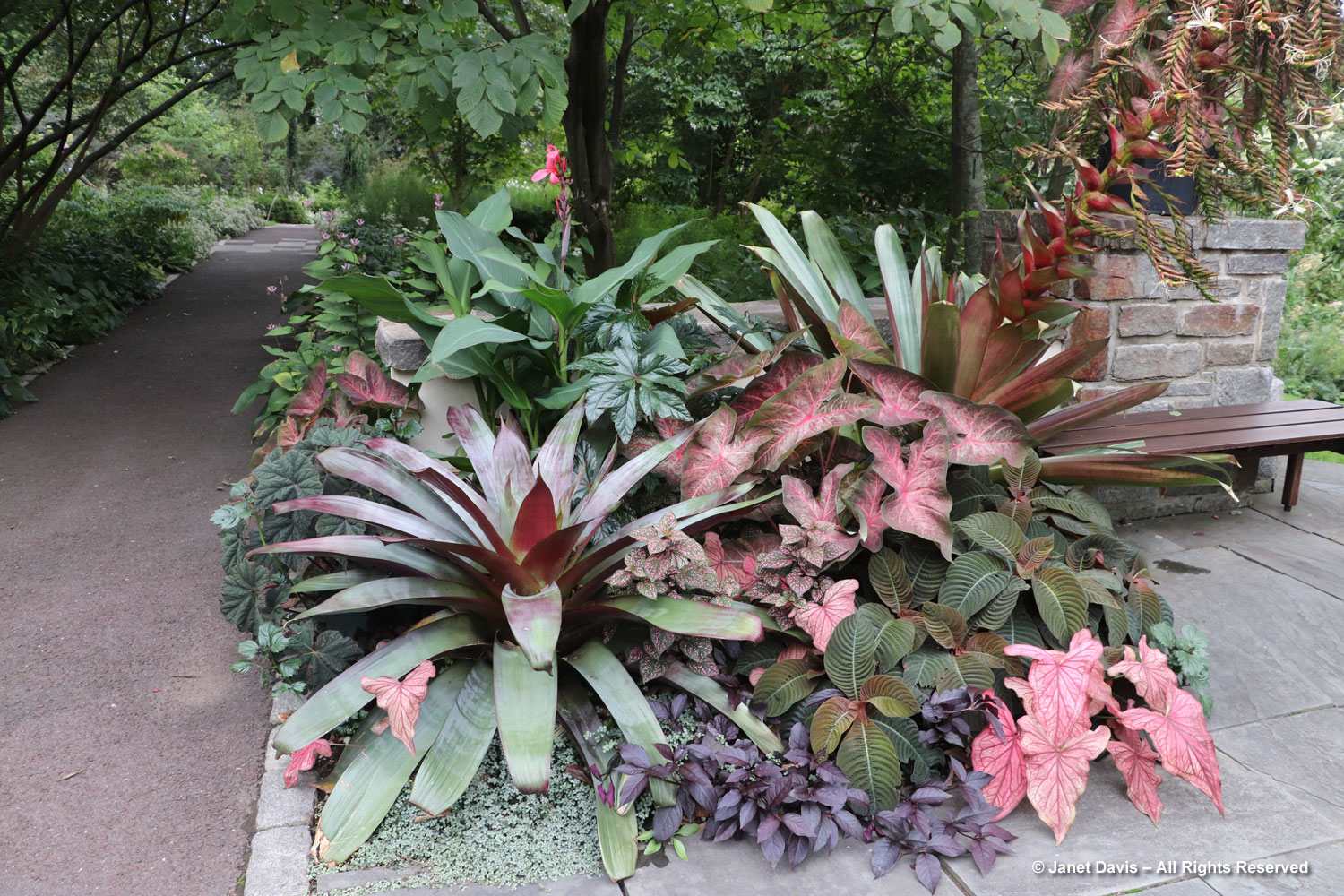
And as if these precious hours at Chanticleer weren’t enough, along with food and drinks there was a great band.

We danced! Even those of us with aching knees from walking up and down the garden’s hills danced. It was another visit we won’t soon forget. Thank you Bill Thomas and the entire Chanticleer team. You are simply the best.
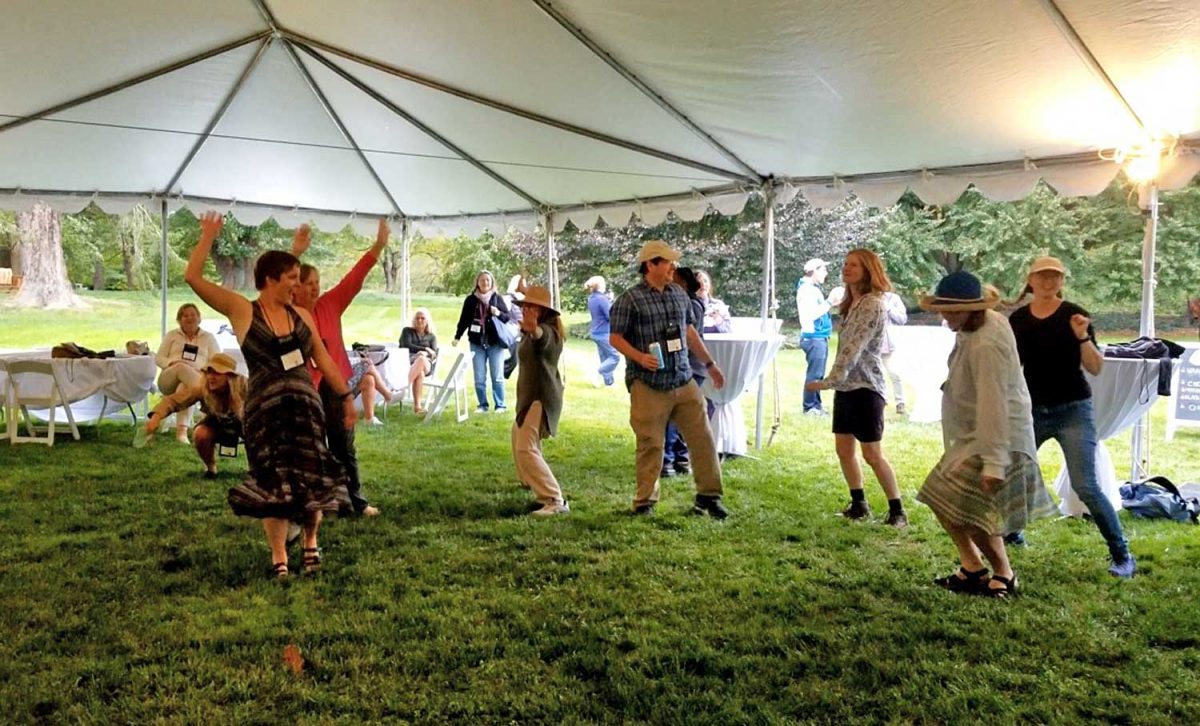

Janet I wish I could have commented on every photo and each of your descriptive texts. So many wonderful combinations. I loved the fern combos.! You must be one of their very favourite visitors. I get so excited when I see something growing at Chanticleer that I have in our garden.Thanks again for taking me along.
Glad to have you on my shoulder, Donna!
What a wonderful post, Janet! Chanticleer is truly a spectacular garden and you’ve do perfect justice to a visit with your photos. Thanks!
Thanks, Lisa. Hard to take a bad photo at Chanticleer.
Wow, what a fabulous tour! Can’t believe you had the energy to dance afterwards, LoL.
Haha. You should have seen me try to get out of the hotel bed at 6 am the next morning to head out again.
Simply the best!
Loree, absolutely agree. And I’ll bet you found some choice dangerous plants in Lisa Roper’s Gravel Garden….
Oh Chanticleer…your photos are amazing, as always, Janet. I’m still trying to process the magic of Chanticleer. I’m imagining a return visit…maybe next time in spring or early summer. Your words and photos are lovely.
Beth, you MUST go back. Mid-June is fabulous. I’ve never been in July or August, but I think I need to complete the seasons!
Thanks for the kind words.